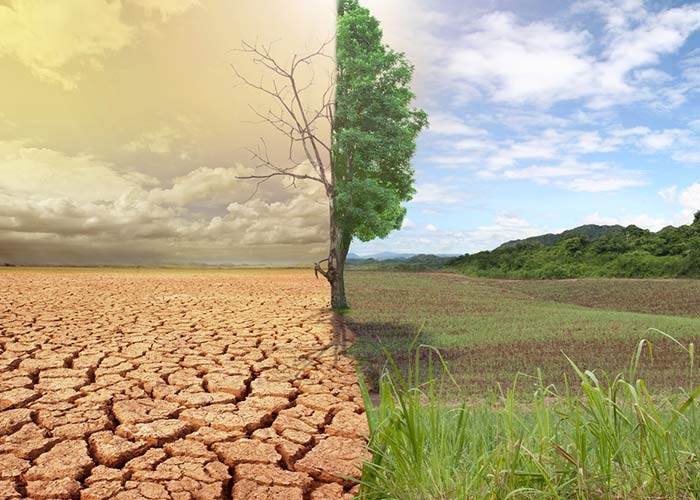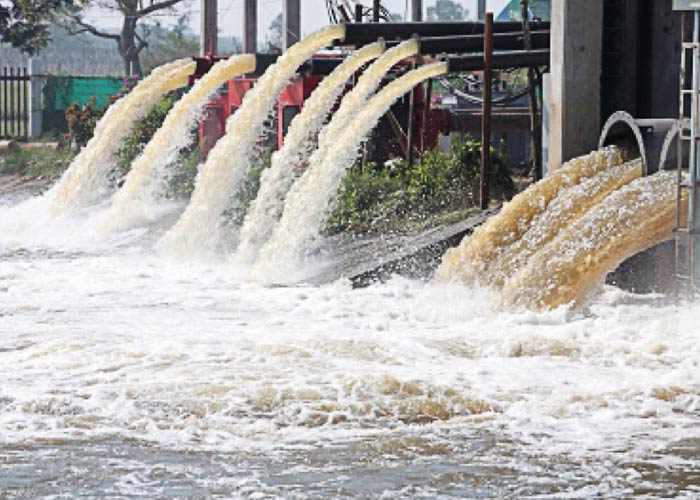Greenhouse effect is a complex process in which the surface and atmosphere of the Earth become warm by the complexities of sunlight radiation and particles and gases present in the environment. A part of the sun’s heat is radiated back to the space, but some of it does not go back due to the layer formed by greenhouse gases that absorb the remainder of the heat. Greenhouse gases found in the atmosphere create a thick circle, with the result that the sun’s heat does not go back into the space and the temperature increases on the Earth.
Increasing temperatures of the Earth has led to the phenomenon of global warming. It has led to unprecedented discrepancies in climate change across the globe. This has threatened the existence of coastal places and islands. Due to global warming, the availability of water for drinking water and irrigation is also likely to be affected. If there is a flood in the desert, then there is drought in the areas with dense rain. The glaciers of the snow regions are melting with mounting temperatures. Also, in developing countries like India based on irrigation, there is a danger of a change in crop circle.
In the wake of ill-effects of global warming, many countries of the world have signed a treaty towards reducing the transmission of greenhouse gases under the U.N. Framework Convention on Climate Change (UNFCCC).
Difference between Greenhouse Effect and Global Warming
When the sun’s radiation enters the Earth’s atmosphere, this radiation has a series of wavelengths. The greenhouse gases surrounding the earth – carbon dioxide, water vapour, nitrous oxide, methane, chlorofluorocarbon, etc – have the ability to absorb a large amount of this radiation and emit it as infrared radiation. Some radiations return to outer space, but most of this infrared radiation is absorbed by the Earth’s surface, the ocean and the atmosphere. By this exchange of radiation the atmosphere on Earth becomes fit for living organisms. This is termed as greenhouse effect.
In other words, without the greenhouse effect, the average temperature of the Earth will be 18 degree Celsius (°C), instead of the current normal mean of 15 °C. In that scenario, normal life is not possible. The credit for maintaining the normal temperature of the Earth goes to proper balance of greenhouse gases. Problems arise when their volume increases. With the imbalance in greenhouse effect due to unusual increase in greenhouse gases, the temperature of the Earth’s surface and atmosphere is gradually increasing, leading to global warming. Since the Industrial Revolution, the increased amount of greenhouse gases has aggravated the greenhouse effect, leading to global warming.
Origin of Greenhouse Effect Nomenclature
In some parts of the Earth, such as in Antarctica, the sunlight does not reach in as much quantity as it is required. In such areas, it is problematic to grow fruits and vegetables without adequate sun rays.
Vegetables and fruit plants are grown in glass houses (greenhouses) in some cold regions where the external temperature is extremely low. The interior of the glass house remains warmer than the outside because the glass allows the sunlight to come in; but it does not allow the radiation to go out. Sunlight in this greenhouse comes by transparent glass. Reversed heat or radiation does not cross each other because a specific part of radiation is absorbed by the glass. This keeps the interior of the greenhouse warm, which is useful for plants and fruits.
It is a kind of system in which a field is made of some elements where the sun’s radiation can easily penetrate but cannot go away. That way plants of that area get adequate sunlight, and achieve their overall development. Since this method greenhouse method is used in the areas where sunlight is not available for the entire day of the year or reaches very few parts, the term ‘greenhouse effect’ has become popular. In fact, the atmosphere that surrounds the Earth works like a greenhouse. It allows the sunlight to pass through it and absorbs the terrestrial radiation. The Earth provides electromagnetic radiation of high wavelength, here the Earth acts like a black body, which is also a good radiator. But with the disruption in the harmony of greenhouse gases, more heat than required is being absorbed in lower environments, which has led to the phenomenon of global warming.
Distribution of Greenhouse Effect
The main sources of energy are –
- Radiation energy (solar energy)
- Thermal energy
- Chemical energy (bonds in organic compounds)
- Mechanical energy (two types of static energy (accumulated energy) and kinetic energy (useful energy).
The sun is the source of all kinds of energy for the living beings on the Earth. It creates a lot of nuclear fusion, which spreads the amount of electromagnetic waves in all directions. The radius of radiation energy is 390 nm to 720 nm, which is distorted in the form of solar radiation, in which very few parts reach the Earth’s atmosphere. The magnetic radiation receives 1, 73000×1012 watts of energy from which 30% radiation is radiated in the universe; 23% radiation is used in water cycle in water vapour and moisture; 47% radiation is absorbed by the atmosphere, the Earth and the ocean; less than 1% radiation is used in air and air flow, and only about 0.01% radiation is used in photosynthesis.
The solar radiation happens in the form of short waves. On entering the sun’s atmosphere, some part of it gets radiated to the space, some part is absorbed by the atmosphere and the rest reaches the Earth’s surface. There is a microscopic balance of heat on the Earth. Of the 100 units of sunlight, 35 units are converted and merged into space, 17 units are distilled from the surface of the Earth and the atmosphere radiates 48 units. In this way, the receipt and loss of heat becomes equal.
The atmosphere absorbs 14 units of the sunlight and 34 units come from the terrestrial radiation. The airwaves radiate these 48 units of energy back into space. The surface of the Earth absorbs 21 units of sunlight and distributes the same quantity, so it can be said that the atmosphere is not warmed directly by the sun, but it is heated with terrestrial radiation.
Types of greenhouse gases
- Carbon Dioxide (CO2)
This is the main greenhouse gas. Its main source includes coal combustion, deforestation, and cement industry.
- Methane (CH4)
This is the second most important greenhouse gas. Its main sources include agricultural practices, the process of bacteria, anaerobic decomposition of organic matter, combustion of coal and oil at electric power plants, and also during the combustion of gasoline in automobiles.
- Nitrous Oxide (N2O)
This gas contributes 6% to the greenhouse effect. Its main sources are: fertilizer, bacteria and fungi in soils and oceans, and coal combustion.
- Halocarbon
It is a human-produced chemical compound consisting of elements of the halogen family, carbon and other gases, including hydrocarbons (HFC) perfluorocarbon (PFC) and sulphur-hexafluoride (SF6).
- Surface Ozone (O3)
It is an important greenhouse gas present in the troposphere, which comes from industrial activities.
- Water vapour
It is obtained from natural respiration, and evaporation. When the Earth’s temperature increases, its volume increases in the atmosphere.
Causes of Global Warming
The amount of carbon dioxide in the environment is increasing due to rapid industrialization and destruction of forests. A sheet of carbon dioxide is formed in the atmosphere, blocking the incoming infrared rays of the sun. With this thermal energy imprisoned in the atmosphere, the average temperature of Earth increases, which is called ‘global warming’ or ‘global heating’. Global warming is currently a universal problem. No country in this world is untouched by this threat. The Earth’s temperature is constantly increasing with the emission of greenhouse gases.
Carbon dioxide is the most important gas in greenhouse gases. Through the carbon cycle, its level remains normal in the atmosphere. But this is not happening for the past few decades. Its volume is increasing in the atmosphere continuously. Too much fossil fuel usage, deforestation and land use change are the main reasons of this increase. According to a report of the Inter-Governmental Panel on Climate Change (IPCC), in 1880-1890, carbon dioxide content was about 290 parts per million (ppm), which increased to 340 ppm in 1990 and 400 ppm in 2000.
Carbon dioxide is majorly responsible for global warming, but methane, chlorofluorocarbons, nitrous oxides, ozone, sulphur dioxide and water vapour are also aggravating it. Carbon dioxide’s contribution in global warming is 50 percent, methane 18 percent, chlorofluorocarbon 14 percent, and nitrous oxide 6 percent. Chlorofluorocarbon was invented in the United States in 1930-31. Due to being flammable, chemically inactive and non-toxic, it has been identified as an ideal refrigerant. It is widely used in refrigerators, air-conditioning equipment, electric, plastic, pharmaceutical industries and aerosols.
The amount of methane gas in the atmosphere is also increasing in concentrated form. In the past 100 years, the concentration of methane gas has more than doubled. The quantity of gases such as chlorofluorocarbon, nitrous oxide and sulphur dioxide etc. is also increasing steadily. With this increase in greenhouse gases, their ability to absorb radiation in the atmosphere is constantly increasing. So, the temperature of the Earth is constantly increasing, giving rise to the phenomena of ‘global warming’.
CFC-14 (Tetra fluoro methane) and CFC-16 (Tetra fluoro methane) is emitted by the aluminium industry. Its ability to heat the Earth is 800 times more than that of carbon dioxide. On an average, production of 1 ton aluminium produces 1.6 kg CFFC-14 and 0.2 kg CFFC-16 gases. Sherwood Rowland and Marrio Mobina, affiliated to the University of California, demonstrated from their research in 1974 that the chlorine present in the CFC causes the disintegration of ozone molecules i.e., damages the ozone layer present in the atmosphere.
Consequences of Global Warming
In the last decade, the environment continues to be polluted by uncontrolled industrialization, unplanned urbanization, population growth and many living activities. Presently, due to the indiscriminate race for requirements, the amount of carbon dioxide in the atmosphere has increased by about 31 percent. As a result, severe climate conditions like extreme rainfall and drought are occurring.
At present, the temperature of the Earth has increased from 0.2 degrees Celsius to 0.6 degree. In the near future, it may increase from 1.4 degrees C. to 5.8 degrees C. As a result of the temperature rise, the glaciers will melt rapidly, the water level of the sea will increase, due to which many coastal cities will be submerged. Such a situation would be disastrous for human life.
The consequences of this temperature rise will be horrible. With rising temperature, there will be outbreaks of fierce hot winds and vicious storms. Due to the increased temperature, the poles will start melting, which will rise above sea level, as a result, many countries like Maldives and Bangladesh will be submerged.
Need for reduction in greenhouse effect
Reduction in greenhouse gases is difficult but not impossible. A number of national and international level organizations are working on this. Some important steps by which their emissions can be reduced include:
- There should be an increase in energy efficiency in consumption and production. It calls for environment-friendly vehicle technology and electric devices.
- The fuel must be optimally utilised in vehicles that it is possible with fine maintenance.
- The use of new sources of energy like solar energy, hydroelectric energy, nuclear energy etc must be encouraged.
- The emission of toxic substances derived from industries should be reduced.
- The production of the halocarbon should be reduced, for example, cyclic chemicals should be used in refrigerators, air conditioners, again.
- The use of petrol or diesel-run vehicles should be reduced.
- Forestry should be promoted and forests should be prevented from cutting.
- Oceanic algae should be increased so that carbon dioxide can be used by photosynthesis.
Conclusion
The above-mentioned steps provide some instances only. More such efforts are needed to be taken up by government, non-governmental organizations, concerned citizens and the society as a whole. Their main purpose is to reduce the greenhouse effect and prevent complex problems generated by global warming. By these steps, the ill-effects of abnormal rise in greenhouse effect can be tackled, so that the mankind heads for a better future.







